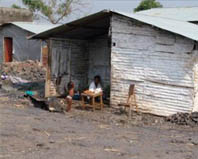
|
“I WANT TO HELP, WHAT CAN I DO NOW?” an alternative approach for new groups is to focus on existing active small group aid programs, and find examples of the most practical program for the particular interests of a new peacemakers group. One way to get started on this is to search out and talk to people in one’s home city or province who have aid staff located in less developed regions and can advise on potential projects most suitable for peacemakers groups’ areas of interest. Many local peacemakers will have had field experience in various foreign countries of interest. Person-to-person contact with experienced aid administrators of field staff is much better than a printed page or phone calls. Assuming a potential peacemaker is talking to concerned friends, the next step is for the friends to meet and explore the idea of forming a Peacemakers group. This will be a very important first step, requiring a meeting at least once a month, probably in the evening. Most new groups of peacemakers are “single purpose” to start with. Some peacemakers will enjoy going to seminars, workshops, and public lectures. Experience shows that these should not replace the first group meetings, but could add to the knowledge that team members bring back to the group. It is important to follow up the meetings and start organizing in a very business-like way as a group—to have rotating chairmen, meeting agendas, brief minutes, a treasurer/accountant, and a secretary—all volunteers. A non-profit charitable organization could be registered to give income tax deductibility for financial donations, as appropriate. Without this all the “busy” people would not continue to be involved, for all the familiar reasons. It is often asked, “Why are many people under, say, forty, not interested and activist peacemakers now?” One reason may be that they will not get involved until something new and different is tried and appeals to them. Most of them have not joined existing peace societies up to now, and probably would not do so in future until they realize that something different must be done to advance the cause of peace before it is too late. The challenge to repair the destruction of warfare and remove the causes must be faced now by today’s generation, guided only by the degree to which they have learned the ways of peace in a peacemaking family, in a peaceful society. Before September 11, 2001, most persons left it up to governments to handle the problems of peace and war. But that has now changed. The problems of war affect whole populations directly. Peacemaking has now become a matter of serious public concern. We face the probability that future internal wars and terrorism may carry on for generations. Parents today know that the many threats to peace on the horizon will affect future generations. To face in the future another last chance for peace, as in the Cuban nuclear crisis, would be intolerable. Peace-loving peoples must find ways to disarm the threat of another September 11 crisis, or of an attack with weapons of mass destruction by unknown enemies. Making today’s peacemaking more effective would be a good first step. It is obvious that the more new peacemakers recruited at the grass roots, the greater the ability of the grass roots to meet their responsibility to be a new partner in peacemaking. The successful history of the new role of many peacemaking groups at the grass roots level confirms the importance of individuals forming activist groups rather than “going it alone.” Personal financial donations are, of course, helpful, but these will not meet the mountain of needs for hands-on contacts and support of the less developed world. All of the peacemaking groups described in Chapters 6 to 9 started as small groups. They have grown to large organizations and are continuing to do all that they can in their respective fields of interest. Peace is increasingly under attack today, and peacemaking needs major reinforcements now—new teams that can make a difference and add to the power of the grass roots. The only entity that can add to existing peacemaking is the individual, so here is where we must look for new reinforcements. Individuals can maximize their strength by working in small groups that stimulate ideas, energy, action, and enhanced results. Anyone will be welcome to join existing peace groups which are already in the field and fully engaged. However, the compelling requirement now is to meet the increasing need for peacemakers who will be a wholly new force of reinforcements—much like the initial fourteen young Greenpeace volunteers. Many “young people” today—of whatever age—are attracted to activist peacemaking groups, such as Amnesty International, Doctors Without Borders, and Campaign to Ban Landmines, and they keep these associations for many years. A common experience is to make many friends both at home and abroad, and to develop a life-time interest in peacemaking. It is not a commitment to the fad of the year, but to a work that gives the great satisfaction of making a difference to the future of humanity. |
|||
 |
|||
|
“Hold on to dreams For if dreams die, Life is a broken winged bird And cannot fly.”
Langston Hughes American poet
|
|||
 |
|||